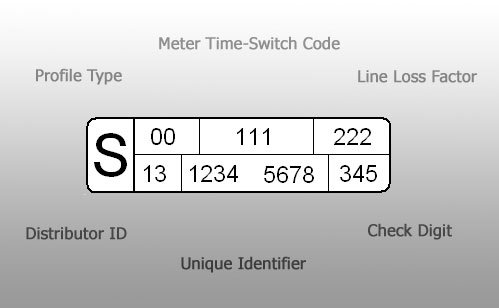Understanding Meter Reference Numbers
Electricity Meter Point Administration Number (MPAN)
This reference number can be found on your Electricity invoice and shows the type of meter you have. On this page we explain the meaning of the different elements of the codes.
Profile Class
Profile classes provide the electricity supplier with an expectation as to how electricity will be consumed throughout the day. The first two digits on the top line of a full MPAN reflect its profile type. These range from 00 to 08 and are broadly separated into two categories, Half-Hourly (HH) and Non-Half-Hourly (NHH).
These terms are a reference to the availability capacity of the supply in kVA or in other words the amount of electricity required to power the property. A 00 profile is half-hourly and this means that in a particular half-hour period it can use 100 kVA or more. The supply must consume more than 100 kVA for at least half-hour in at least three quarters of a year. If the supply consecutively draws this much energy, the installation of a Half-Hourly meter is mandatory.
00 - Half-hourly supply
01 - Domestic, Single rate
02 - Domestic, Day / Night split, also referred to as Economy 7
03 - Commercial, Single rate
03 - Commercial Day / Evening & Weekend
04 - Commercial, Day / Night
04 - Commercial, Day / Night / Evening & Weekend
05 - Commercial Maximum Demand- Poor Load Factor (0-20% Load)
06 - Commercial Maximum Demand- Medium Load Factor (20-30% Load)
07 - Commercial Maximum Demand - Good Load Factor (30-40% Load)
08 - Commercial Maximum Demand - Excellent Load Factor (>40% Load)
Meter Time Switch Code (MTC)
The Meter Time Switch Code indicates how many registers (set of meter reads or dials) your electricity meter has and what times they will operate during the day. The Meter Time Switch Code will show if your meter has two registers, one which records day consumption, the other night.
Line Loss Factor (LLF)
The Line Loss Factor code stipulates the expected costs the distribution company will charge the supplier for using the cables and network in your region. This Line Loss Factor code will also indicate to the electricity supplier the potential charges incurred, due to loss of energy incurred whilst getting the electricity supplier to your meter.
Distributor ID
The Distributor ID will identify the local Distribution Network Operators (DNOs) for your electricity supply. The DNO is responsible for management of the distribution system and electricity wires which transport the electricity to your meter.
Meter Point ID Number
This is a unique number within the distribution area to identify the actual metering point.
Check Digit
This number is calculated from the Distributor ID and Meter Point ID to provide a check digit that other systems can use to validate both numbers.
Profile classes provide the electricity supplier with an expectation as to how electricity will be consumed throughout the day. The first two digits on the top line of a full MPAN reflect its profile type. These range from 00 to 08 and are broadly separated into two categories, Half-Hourly (HH) and Non-Half-Hourly (NHH).
These terms are a reference to the availability capacity of the supply in kVA or in other words the amount of electricity required to power the property. A 00 profile is half-hourly and this means that in a particular half-hour period it can use 100 kVA or more. The supply must consume more than 100 kVA for at least half-hour in at least three quarters of a year. If the supply consecutively draws this much energy, the installation of a Half-Hourly meter is mandatory.
00 - Half-hourly supply
01 - Domestic, Single rate
02 - Domestic, Day / Night split, also referred to as Economy 7
03 - Commercial, Single rate
03 - Commercial Day / Evening & Weekend
04 - Commercial, Day / Night
04 - Commercial, Day / Night / Evening & Weekend
05 - Commercial Maximum Demand- Poor Load Factor (0-20% Load)
06 - Commercial Maximum Demand- Medium Load Factor (20-30% Load)
07 - Commercial Maximum Demand - Good Load Factor (30-40% Load)
08 - Commercial Maximum Demand - Excellent Load Factor (>40% Load)
Meter Time Switch Code (MTC)
The Meter Time Switch Code indicates how many registers (set of meter reads or dials) your electricity meter has and what times they will operate during the day. The Meter Time Switch Code will show if your meter has two registers, one which records day consumption, the other night.
Line Loss Factor (LLF)
The Line Loss Factor code stipulates the expected costs the distribution company will charge the supplier for using the cables and network in your region. This Line Loss Factor code will also indicate to the electricity supplier the potential charges incurred, due to loss of energy incurred whilst getting the electricity supplier to your meter.
Distributor ID
The Distributor ID will identify the local Distribution Network Operators (DNOs) for your electricity supply. The DNO is responsible for management of the distribution system and electricity wires which transport the electricity to your meter.
Meter Point ID Number
This is a unique number within the distribution area to identify the actual metering point.
Check Digit
This number is calculated from the Distributor ID and Meter Point ID to provide a check digit that other systems can use to validate both numbers.
Gas Meter Point Reference Number (MPRN)
This number is found on your gas bill and consists of one long number with up to 10 digits. It may be located at the top or bottom of the bill. The number does not contain any letters.

